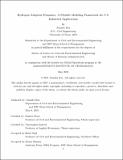| dc.contributor.advisor | Knittel, Christopher | |
| dc.contributor.advisor | Plata, Desiree | |
| dc.contributor.author | Ray, Jennifer | |
| dc.date.accessioned | 2025-10-21T13:18:10Z | |
| dc.date.available | 2025-10-21T13:18:10Z | |
| dc.date.issued | 2025-05 | |
| dc.date.submitted | 2025-06-23T17:09:05.727Z | |
| dc.identifier.uri | https://hdl.handle.net/1721.1/163297 | |
| dc.description.abstract | As climate change concerns drive the need for decarbonization, hydrogen stands as a potential tool to help reduce emissions across the United States industrial and energy sectors. This thesis develops a flexible modeling framework for hydrogen adoption across multiple industrial applications, designed specifically to support strategic investment decision-making in an evolving market. The tool analyzes six major industries – steel, chemicals, energy storage, biofuels, vehicles, and natural gas– through two metrics: potential hydrogen consumption and threshold prices for economic viability. The framework applies scenario analysis to examine how government policy and technological advancement influence potential market trajectories.
Analysis reveals significant sensitivity to input assumptions. Even small variations in the assumed initial hydrogen production cost can result in significantly different adoption timelines. In scenarios where initial hydrogen production costs are $5/kg, widespread adoption requires maximum policy support and technological progress. However, reducing the initial cost by just $1 to $4/kg makes broader adoption feasible with less reliance on government intervention. Light-duty fuel cell electric vehicle penetration rate and steel industry growth rate emerge as the most sensitive parameters affecting overall hydrogen demand, followed by biofuel blending rate and hydrogen injection percentage into natural gas infrastructure.
The vehicles industry is identified as a first mover in widespread hydrogen adoption, followed by steelmaking and methanol production. Hydrogen adoption for natural gas blending, methanol for export, and methanol-to-gasoline applications occur later due to their lower threshold price for economic viability. Under optimal conditions with strong government support and significant technological advancements, total hydrogen demand could reach 48.8 million metric tons by 2050, approximately a sevenfold increase from scenarios with minimal support.
The tool’s value lies not in projecting a definitive, single-point forecast, but in providing a flexible framework that helps stakeholders navigate market uncertainties as the decarbonization landscape evolves. Future research should integrate supply-side dynamics, infrastructure requirements, and geographic variability to enhance projection accuracy. | |
| dc.publisher | Massachusetts Institute of Technology | |
| dc.rights | In Copyright - Educational Use Permitted | |
| dc.rights | Copyright retained by author(s) | |
| dc.rights.uri | https://rightsstatements.org/page/InC-EDU/1.0/ | |
| dc.title | Hydrogen Adoption Dynamics: A Flexible Modeling Framework for U.S. Industrial Applications | |
| dc.type | Thesis | |
| dc.description.degree | M.B.A. | |
| dc.description.degree | S.M. | |
| dc.contributor.department | Sloan School of Management | |
| dc.contributor.department | Massachusetts Institute of Technology. Department of Civil and Environmental Engineering | |
| mit.thesis.degree | Master | |
| thesis.degree.name | Master of Business Administration | |
| thesis.degree.name | Master of Science in Civil and Environmental Engineering | |
